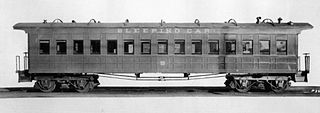
The sleeping car or sleeper is a railway passenger car that can accommodate all passengers in beds of one kind or another, for the purpose of sleeping. George Pullman was the American innovator of the sleeper car.

First class is the most luxurious and most expensive travel class of seats and service on a train, passenger ship, airplane, bus, or other system of transport. Compared to business class and economy class, it offers the best service and most comfortable accommodation.
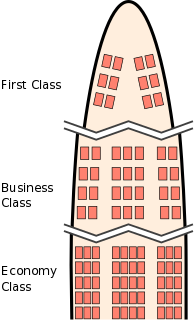
A travel class is a quality of accommodation on public transport. The accommodation could be a seat or a cabin for example. Higher travel classes are designed to be more comfortable and are typically more expensive.
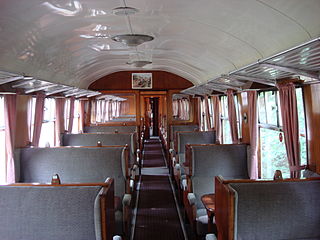
British Railways Mark 1 is the family designation for the first standardised designs of railway carriages built by British Railways (BR) from 1951 until 1974, now used only for charter services on the main lines or on preserved railways.
There are three basic types of Norwegian railway carriage used commonly by NSB on the Norwegian railway system, the Class 3, Class 5 and Class 7 series. As of 2005, the carriages are hauled by NSB El 18 engines on the main electrified stretches and NSB Di 4 engines on non-electrified lines.

Swing Door trains, commonly known as "Dogboxes" or "Doggies", were wooden-bodied electric multiple unit (EMU) trains that operated on the suburban railway network of Melbourne, Victoria, Australia.

The S type carriages are a corridor-type passenger carriage used on the railways of Victoria, Australia. The first carriages were constructed by the Victorian Railways in 1937 for use on the Spirit of Progress, with additional carriages built for other trains until the mid-1950s.

The Z type carriages are an air conditioned steel passenger carriage used on the railways of Victoria, Australia. The carriages were constructed by the Victorian Railways from 1957 for use on intrastate services.

The NZR 56-foot carriage is a class of 56 ft (17 m) long railway passenger carriage formerly used on almost all long-distance passenger rail transport in New Zealand. 88 carriages have been preserved.
The V type carriages, introduced from 1897, were the first group of Victorian Railways passenger rolling stock to have their own distinct class.
The New South Wales stainless steel carriage stock was a type of passenger carriage operated by the New South Wales Government Railways from 1961 until 1993.
This article is intended as a catalogue of sleeping carriages used by the Victorian Railways and successors.
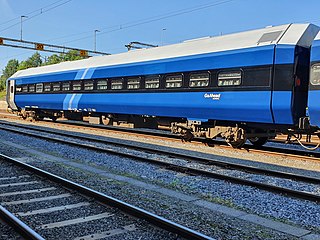
NSB WLAB-2 or WLAB2 is a class of twenty sleeping cars built by Strømmens Verksted for the Norwegian State Railways (NSB). They serve as the sole sleepers in Norway, being used on the Bergen Line, Dovre Line, Nordland Line and Sørlandet Line. Each car features fifteen compartments, which can each be utilized with a single or twin bunk configuration. The carriages have a unique octagonal shape, are 27 meters (89 ft) long and weigh 48 tonnes.
This page outlines the history and evolution of Victorian Railways (Australia) bogie passenger carriages, constructed with steel underframes and timber bodies up to 59 ft 90 in (20.2692 m) long, along with a handful of other carriages from the era.
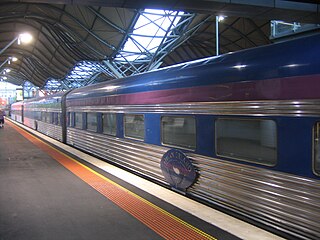
The first carriages built specifically for The Overland train service operated by the Victorian and South Australian Railways were introduced in 1949. By the end of 1951, eight new sleeping cars and six new sitting cars had entered service. Additions to the fleet continued until 1972; in all, 44 carriages were built. About eight were still in service in March 2020 on The Overland operated by Journey Beyond. Other carriages have been transferred to different services or sold.
The PL type carriages were a series of 141 wooden passenger carriages used on the railways of Victoria, Australia. They consisted of the first class APL, second class BPL and combination second and guard's van, BCPL's.

V&SAR Intercolonial Express Carriages were carriages on a new train called the Intercolonial Express running on Victorian Railways and South Australian Railways in 1887. The track of two railways met on Wednesday 19 January 1887. The Victorian Railways' Western Line to Dimboola, and the South Australian Railways' Wolseley line, met at Serviceton. Since both sides shared the broad gauge of 5'3", an agreement was made between the two railways allowing a pool of carriages, classed O, to be specifically allocated to interstate trains linking the capitals of Melbourne and Adelaide. The operating and maintenance cost of the new train would be funded by both railways, roughly 60% paid for by the Victorian Railways and 40% by the South Australian Railways.
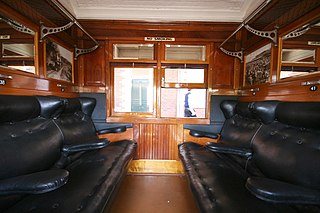
The E type carriages were wooden express passenger carriage used on the railways of Victoria, Australia. Originally introduced by Victorian Railways Chairman of Commissioners Thomas James Tait for the interstate service between Melbourne, Sydney and Adelaide, these Canadian-inspired carriages remained in regular service for 85 years over the entire Victorian network.

The W type carriages were wooden passenger carriages used on the railways of Victoria, Australia.
This article outlines the history and types of passenger rolling stock and guards vans on the narrow-gauge lines of the Victorian Railways in Australia. The types were constructed in parallel with very similar designs.













